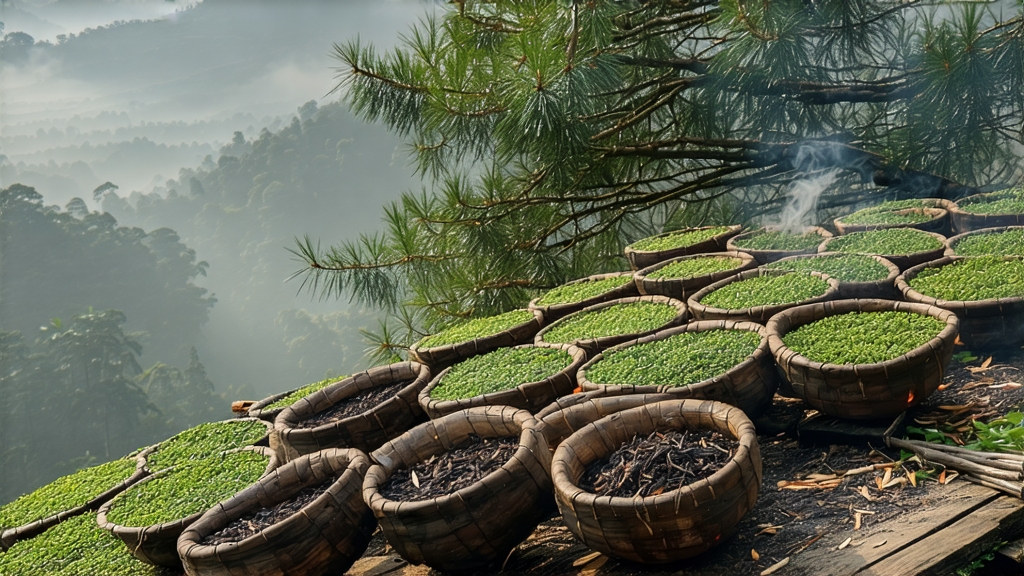
If every family tree has a patriarch, then the sprawling genealogy of black tea begins with a single, audacious leaf from the Wuyi Mountains of Fujian Province—Lapsang Souchong. Western catalogs often treat it as a curiosity, a “smoked tea” relegated to perfumed blends or Christmas gift baskets, yet in the high valleys that gave it birth it is still called zhengshan xiaozhong, “small-leaf original-mountain,” a name that quietly insists on authenticity and place. To understand this tea is to witness the moment when Chinese green-tea orthodoxy cracked open, letting oxidation rush in and create the first fully red liquor the world had ever seen.
Legend places the birth moment in 1568, late Ming dynasty, when a passing army commandeered a tea factory near Tongmu village. The leaf, already withered, risked total spoilage; in desperation the workers dried it over fresh pine fires so it could travel to market. The Dutch, first Europeans to taste it at Batavia (today’s Jakarta), sent it onward to London where Catherine of Braganza would make it fashionable in Charles II’s court. Thus the smoky leaf that saved a village became the prototype for every future Keemun, Assam, Ceylon and Darjeeling, its very name “souchong” (from xiao zhong, “small sort”) entering world commerce as a grade of black tea.
True Lapsang Souchong is inseparable from its terroir: a 56 km² national preserve inside the Wuyi Biosphere where no outside tea leaf may legally enter. The canyon is so steep that sunrise arrives two hours later on the valley floor; humidity lingers at 85 %, feeding moss-covered oaks and massive Cunninghamia pines whose resin will later scent the tea. Only two cultivars are sanctioned—Xingcun Xiaoye and Wuyi Caicha—both low-yield bushes that hug the rocky soil, drawing minerality from weathered tuff and imparting a natural cinnamon sweetness that balances forthcoming smoke.
The craft begins before dawn in late April, when buds have opened into the standard two-leaf-and-a-bud pluck. Leaves are laid into bamboo trays set over river-bed boulders whose residual warmth provides a gentle 28 °C withering; this “rock wither” reduces moisture without forcing grassy volatiles upward. Once the leaf feels like soft leather—limp yet resilient—it is rolled 45 minutes on rattan mats, a quieter kneading than the machine bruising seen in Assam, preserving some cell walls so that oxidation proceeds slowly.
Oxidation happens inside wooden cupboards lined with wet cotton; pine charcoal smolders in a pit beneath, raising ambient temperature to 24 °C and nudging polyphenols toward theaflavins rather than heavier thearubigins. After three hours the leaf has turned a liver-brown with copper edges; now comes the step that divides the orthodox from the merely smoked. In Tongmu the firing room is a squat stone structure whose ceiling is black with decades of resin. Freshly split Masson pine is stacked into a trench; long-armed shovels toss the tea onto bamboo racks two meters above the embers. For eight minutes the leaf is turned constantly, absorbing volatile guaiacol and syringol—the same molecules that give smoked bacon its aroma—yet because the fire is indirect, the tea remains dry, not cooked. A second, cooler firing follows, mellowing the smoke and fixing the now-iconic amber-red color.
Grading happens by nose alone. Master Chen Shihong, fifth-generation, swirls a handful of cooled leaf inside a gaiwan lid; if the rising aroma recalls longan fruit laced with pine sap, the batch is “zhengshan” grade, worthy of export under its own name. If the smoke dominates, it becomes “waisshan,” sold to flavor Earl Grey bases. The finest lots, fewer than 300 kg per spring, rest one month in fir-wood chests so that pine phenols integrate with malty tannins, yielding a liquor both ethereal and sturdy.
To brew Lapsang Souchong gongfu style is to conduct a small chamber concerto. Begin with soft water brought to 95 °C; hard water exaggerates tannin and turns smoke acrid. Pre-warm a 120 ml porcelain gaiwan, then measure 5 g of leaf—about two heaping teaspoons of the wiry, jet-black ribbons. The first infusion,